Related Research Articles

The Dales Pony is a British breed of pony or small horse. It originated in, and is named for, the Dales of Yorkshire in northern England. It is one the nine native mountain and moorland pony breeds of the United Kingdom, and belongs to the broader Celtic group of ponies which extends from Portugal and northern Spain to Scandinavia.
The Galiceno is a horse breed developed in Mexico, bred from horses brought from Spain by Hernán Cortés and other conquistadors. Although small in stature, they are generally considered a horse, rather than a pony, and are always solid-colored. In Mexico, they are an all-around horse, used for riding, packing and light draft. In the United States they are often used as mounts for younger competitors, although they are also found competing in Western events. The breed descends from horses brought from Spain to Mexico during the 16th century. Many of these horses escaped or were released and formed feral bands in the interior of Mexico, which were then captured by local inhabitants. They were also often used by Spanish missionaries to the American West, where they became some of the ancestors of the American Indian Horse. In 1958, these horses were first imported to the United States, and in 1959 a breed registry was formed. Many of the horses are also registered with the American Indian Horse Registry.
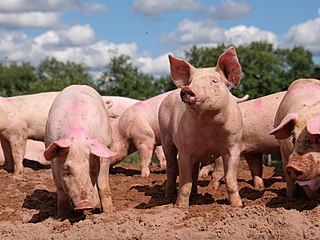
The pig, often called swine, hog, or domesticpig when distinguishing from other members of the genus Sus, is an omnivorous, domesticated, even-toed, hoofed mammal. It is variously considered a subspecies of Sus scrofa or a distinct species. The pig's head-plus-body length ranges from 0.9 to 1.8 m, and adult pigs typically weigh between 50 and 350 kg, with well-fed individuals even exceeding this range. The size and weight of hogs largely depends on their breed. Compared to other artiodactyls, a pig's head is relatively long and pointed. Most even-toed ungulates are herbivorous, but pigs are omnivores, like their wild relative. Pigs grunt and make snorting sounds.

The Gloucestershire Old Spots is an English breed of pig which is predominantly white with black spots. It is named after the county of Gloucestershire. The Gloucestershire Old Spots pig is known for its docility, intelligence, prolificity, and hardiness. Boars reach a mature weight of 600 lb (272 kg) and sows 500 lb (227 kg). The pigs are white with clearly defined black spots. There must be at least one spot on the body to be accepted in the registry. The breed's maternal skills enable it to raise large litters of piglets on pasture. Its disposition and self‑sufficiency should make it attractive for farmers raising pasture pigs and those who want to add pigs to diversified operations.
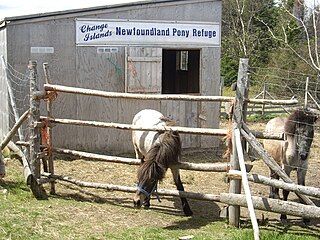
The Newfoundland pony is a breed of pony originating in Newfoundland, Canada. They are sturdy and muscular ponies, found in many colors, including the relatively rare white coloration. The Newfoundland developed from a mix of English, Irish and Scottish pony breeds brought to Newfoundland by settlers over a period of four centuries. Initially free-roaming, they crossbred to produce the modern type. They were used by settlers as draft and multi-purpose ponies until the mid-20th century, when they were brought almost to the point of extinction by mechanization and slaughter. The population rebounded slightly after the formation of a breed registry in 1980, but still remains low. In 1997, the Newfoundland pony was declared a heritage breed of Newfoundland and Labrador, which afforded it protection under the law, but the breed has not yet been recognized under the Canadian federal Animal Pedigree Act. As of 2008, there were 248 registered ponies of breeding age, out of a total population of 361. In 2013, the widely dispersed breeding population is still estimated at between 200 and 250 animals.

The Florida Cracker Horse is a breed of horse from the state of Florida in the United States. It is genetically and physically similar to many other Spanish-style horses, especially those from the Spanish Colonial horse group. The Florida Cracker is a gaited breed known for its agility and speed. The Spanish first brought horses to Florida with their expeditions in the early 16th century; as colonial settlement progressed, they used the horses for herding cattle. These horses developed into the Florida Cracker type seen today, and continued to be used by Florida cowboys until the 1930s.

The Tamworth, also known as Sandy Back and Tam, is a breed of domestic pig originating in its namesake Tamworth, Staffordshire, United Kingdom. It is among the oldest of pig breeds, but as with many older breeds of livestock, it is not well suited to modern production methods and is listed as "threatened" in the United States and "vulnerable" in the UK by the Rare Breeds Survival Trust, as fewer than 300 registered breeding females remain. This animal is of ginger to red colouration and is thought to have descended from wild boars, via native pig stock of Europe. Principal populations today are in the United Kingdom, Australia, the United States, New Zealand, and Canada.
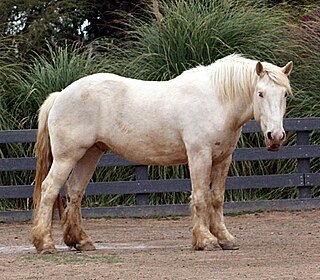
The American Cream Draft is an American breed of draft horse, characterized by the cream or "gold champagne" color of its coat. It was developed in Iowa during the early twentieth century from a cream-colored mare named Old Granny. A breed registry was formed in 1944 but became inactive for several decades when breed numbers dropped due to the mechanization of farming. It was reactivated in 1982 and population numbers have slowly grown since then. It is a rare breed: its conservation status is considered critical by The Livestock Conservancy and the Equus Survival Trust.

The Livestock Conservancy, formerly known as the American Livestock Breeds Conservancy (ALBC) and prior to that, the American Minor Breeds Conservancy, is a nonprofit organization focused on preserving and promoting rare breeds, also known as "heritage breeds" of livestock. Founded in 1977, through the efforts of livestock breed enthusiasts concerned about the disappearance of many of the US's heritage livestock breeds, the Conservancy was the pioneer livestock preservation organization in the United States, and remains a leading organization in that field. It has initiated programs that have saved multiple breeds from extinction, and works closely with similar organizations in other countries, including Rare Breeds Canada. With 3,000 members, a staff of nine and a 19-member board of directors, the organization has an operating budget of almost half a million dollars.
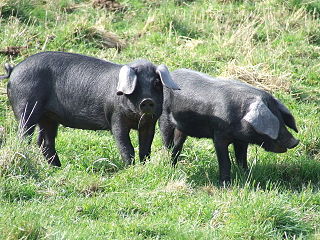
The Large Black pig is a British breed of domestic pig. It is the only British pig that is entirely black. It was created in the last years of the nineteenth century by merging the black pig populations of Devon and Cornwall in the south-west with those of Essex, Suffolk and Kent in the south-east. It is hardy, docile and prolific; it forages well and is suitable for extensive farming, but not well suited to intensive management.

Hog Island sheep are a breed of sheep descended from animals first brought to Virginia's Hog Island in the 18th century. During the 1930s and 1940s, storm conditions forced the island's residents to evacuate, leaving some sheep behind. These sheep adapted to the environment free of human intervention, becoming feral.

Pig farming or pork farming or hog farming is the raising and breeding of domestic pigs as livestock, and is a branch of animal husbandry. Pigs are farmed principally for food and skins.

The Red Wattle Hog is a breed of domestic pig originating in the United States. It is named for its red color and distinctive wattles or tassels, and is on the threatened list of the American Livestock Breeds Conservancy (ALBC).

The Choctaw Hog is a breed of domestic pig historically used by Native Americans. They are now reduced in population to some hundred animals, most of them in the Choctaw Nation of Oklahoma. The American Livestock Breeds Conservancy calls the Choctaw Hog's status "critically rare" and says it "is a high conservation priority."
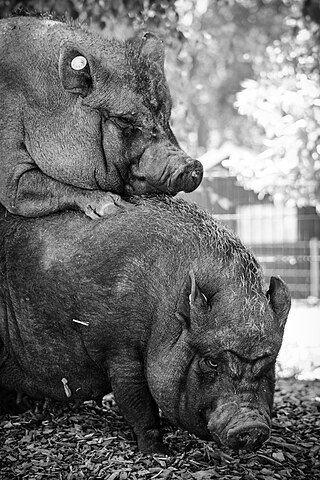
Miniature Pigs, also called mini pig, or Pygmy pig, are small breeds of domestic pig, such as the Vietnamese Pot-Bellied pig, Göttingen minipig, Juliana pig, Choctaw hog, or Kunekune. Miniature pigs can usually be distinguished from other pigs by their pot belly, a swayed back, a chubby figure, a rounded head, a short snout, short legs, a short neck, and a tail with thick hair at the end. Typically, miniature pigs will range in weight from about 70 pounds (32 kg) to 300 pounds (140 kg).

The Meishan is a breed of domestic pig named for the Meishan, Jiangsu Province, China. It is a sub-group of the Taihu pig and is a small to medium-sized breed with large drooping ears, and wrinkled black skin. Meishan Pigs are extremely docile and renowned for their tender and flavorful red meat pork.

The Ossabaw Island Hog or Ossabaw Island is a breed of pig derived from a population of feral pigs on Ossabaw Island, Georgia, United States. The original Ossabaw hogs are descended from swine released on the island in the 16th century by Spanish explorers. A breeding population has been established on American farms off the island, but they remain a critically endangered variety of pig.

The Hereford Hog or Hereford is an American breed of domestic pig. It is named for its color and pattern, which is similar to that of the Hereford breed of cattle: red with a white face.

The Pintabian horse is an American part-Arabian horse breed. It has over 99% Arabian blood, but also exhibits the tobiano color pattern, which is not found in purebred Arabians. The registry began using the term "Pintabian" in 1992 and trademarked the word in 1995. which is the official registering authority for Pintabian horses worldwide.
The Lacombe is a breed of domestic pig native to Canada. Named for the Lacombe Research and Development Centre in Lacombe, Alberta, the breed was the first strain of livestock developed in the country.
References
- 1 2 3 4 Mulefoot Hog, The Livestock Conservancy
- 1 2 3 Mulefoot Hog, Oklahoma State University
- ↑ Conservation Priority Livestock Breeds, 2013 Archived 2013-09-21 at the Wayback Machine , The Livestock Conservancy
- ↑ Maveric Ranch maveric9.com